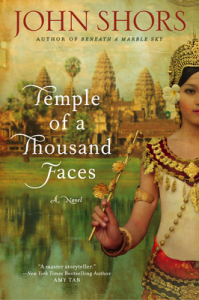A Book Review by Stefanie Field
Temple of a Thousand Faces by Jon Shors
 This book certainly turned out to be much more than I expected. John Shors, famous for his novel, Beneath the Marble Sky, writes a great historical fiction that recreates Angkor Wat and Khmer society in the 12th century. In an age of wars and conquers measured by physical brute strength and the rule of an iron fist, Angkor Wat comes under attack by the ethnic Chams, a neighboring army led by a ruthless king. The story of this conflict is divided among different parties which intersect paths near the end, but each of the characters have a flaw which will play a role in story.
This book certainly turned out to be much more than I expected. John Shors, famous for his novel, Beneath the Marble Sky, writes a great historical fiction that recreates Angkor Wat and Khmer society in the 12th century. In an age of wars and conquers measured by physical brute strength and the rule of an iron fist, Angkor Wat comes under attack by the ethnic Chams, a neighboring army led by a ruthless king. The story of this conflict is divided among different parties which intersect paths near the end, but each of the characters have a flaw which will play a role in story.
The king of Angkor, Jayavar, and his enlightened wife, Ajadevi, are true star-crossed lovers who must decide the best direction to take – flee and rejoin other Khmers for their safety, or take back their home. The Cham king, Indravarman, has a right-hand man and a left-hand man. Asal is a warrior born into poverty who has earned his way to the top, but has no direction or passion in his life and only wants to ensure a proper life for his future children. The assassin Po Rame is Asal’s ultimate rival, eager to torture and take the lives of others for the sake of the hunt. There’s also a fisherman, lover of ordinary life and relative peace, who gets caught up in the war because of his teenage son’s emotional passion.
Like I said before, this novel really brings Angkor to life, despite the fact nearly all of it is fiction. The author does a great job of making an inanimate city, a temple of drastic importance to the region and its culture, into a living character. The temple is raided, is praised, is the center of city life. It suffocates, it breathes, and it gets reborn again. Religion plays a large role in this novel as it’s almost impossible to discuss Angkor Wat without its Buddhist and Hindu elements. You’ll find that religion is an active motivator for all parties in the story, while the author avoids any form of religious advocacy.
However, the book still had a few disappointments. John Shors is well-known for making his historical fiction novels revolve around romantic relationships. They’re a strong part of his stories, but not nearly enough to be considered “romance novels.” I prefer this, but I also felt this book lacked action. For a little more than 500 pages about a city conquered by neighbors, I expected it to be more fast-paced. This also led the story to be somewhat predictable. Regardless, I remained hooked for character development and the interactive environment of Khmer society in 1177. Some of the characters really evolved by the end of the novel, and others were quite static. Despite the religious play for the characters, it was obvious there was a clear line between good and evil. One element that I immensely enjoyed is the role of female characters. They were just as strong and courageous as the men. Although they were initially depicted in “submissive” roles, they quickly dominated the direction of their futures and became very powerful actors in the story.
Overall, I give this novel five out of five stars.
*****
Considering it is fiction, it’s obviously not an accurate portrayal of 12th century Angkor. But the author does a great job in bringing the ancient temple to life. The story has a few disappointments, but I was strongly absorbed by the characters. I would recommend it for those who don’t mind the large aspect of romance in historical fiction. There’s not much action, but it has much discussion on the strategy and intelligence of war.
Stefanie Field is a graduate student pursuing a Master’s Degree in International Relations in Bangkok. She is a lover of books and hopes to promote reading culture in Thailand.

